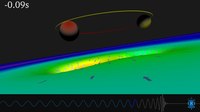
Photo from wikipedia
Existing constraints on the graviton mass from gravitational-wave detections rely on the phase difference developed between different frequencies during the propagation. Effects on the quasinormal-mode frequencies of the black-hole ringdown… Click to show full abstract
Existing constraints on the graviton mass from gravitational-wave detections rely on the phase difference developed between different frequencies during the propagation. Effects on the quasinormal-mode frequencies of the black-hole ringdown due to the graviton mass are often ignored. While perturbation theories of black holes have been well developed in the context of general relativity, this is not the case for modified gravity theories. We propose a phenomenological modification to the Teukolsky equation of perturbed black holes to include the dispersion relation due to a gravitational field of nonzero mass. Solving this modified Teukolsky equation by logarithmic perturbation theory, we compute the shift of the quasinormal-mode frequencies due to the presence of a graviton mass. This hypothetical shift can be used to constrain the graviton mass with ringdown signals, either standalone or in conjunction with the phase difference accumulated due to the wave propagation. We estimate that constraints on the graviton mass of $m_g \lesssim 10^{-15}\,\textrm{eV}$ can be put with a detection of the ringdown signal alone by second generation gravitational-wave detectors.
Journal Title: Physical Review D
Year Published: 2019
Link to full text (if available)
Share on Social Media: Sign Up to like & get
recommendations!